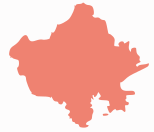world.wikisort.org - India
Tonk district is a district of the state of Rajasthan in western India. The city of Tonk is the administrative headquarters of the district. The district is bounded on the north by Jaipur district, on the east by Sawai Madhopur district, on the southeast by Kota district, on the south by Bundi district, on the southwest by Bhilwara district, and on the west by Ajmer district.
This article needs additional citations for verification. (December 2021) |
Tonk district | |
|---|---|
District of Rajasthan | |
Top: Sudarshanoday Teerth Kshetra, Anwa Bottom: Bisaldeo temple | |
 Location of Tonk district in Rajasthan | |
| Country | |
| State | Rajasthan |
| Division | Ajmer |
| Government | |
| • Zila Pramukh | Saroj Bansal |
| Area | |
| • Total | 7,194 km2 (2,778 sq mi) |
| Population (2011)[1] | |
| • Total | 1,421,326 |
| • Density | 200/km2 (510/sq mi) |
| Time zone | UTC+05:30 (IST) |
| Website | tonk |
Geography
Tonk is on National Highway 12, 100 km from Jaipur. It is in the northeastern part of the state between 75.19' and 76.16 East longitude and 25.41' and 26.24' North latitude. The total area is 7194 km2 (as per 2002-03).
It is one of the four districts headquarters of Rajasthan state that are not directly connected with rail. The nearest railway station, Newai, is within the district but is 30 km from the district headquarters. Banas River flows through the district.
The district is notable for the Tonk meteorite, a rare carbonaceous chondrite meteorite that fell in 1911.[2]
Economy
In 2006, the Ministry of Panchayati Raj named Tonk one of the country's 250 most backward districts (out of 640).[3] It is one of the 12 districts in Rajasthan receiving funds from the Backward Regions Grant Fund (BRGF).[3]
Divisions
Tonk has 9 tehsils and 7 sub-divisions. The 9 tehsils are Deoli, Malpura, Newai, Todaraisingh, Tonk, Peeplu, Uniara, Dooni and Nagarfort. The 7 sub-divisiobs are Deoli, Malpura, Newai, Todaraisingh, Tonk, Peeplu and Aligarh (Uniara). Tonk is Nagar-Parishad while Deoli, Malpura, Newai, Todaraisingh and Uniara are Nagar-Palikas. There were 1093 villages in the district according to the 2001 census.
Notable sights
- Shahi Jama Masjid
- Bisalpur Dam
- Bisaldeo Temple
- Diggi Kalyan Ji Mandir
- Hadi Rani Ka Kund
- Hathi Bhata
- Rasiya Ke Tekri
- Shivaji Park
- Sunehri Kothi
- Maulana Abul Kalam Azad Arabic and Persian Research Institute (APRI)
Culture
Notable personalities
- Ajit Singh Mehta
- Banwari Lal Bairwa
- Masood Ahmed Barkati
- Gulubhai Jasdanwalla
- Karpoor Chandra Kulish
- Kailash Chandra Meghwal
- Chhavi Rajawat
- Jeet Ram
- Prabhu Lal Saini
- Hiralal Shastri
- Akhtar Sheerani
- Hafiz Mehmood Khan Shirani
- Wali Hasan Tonki
- Manikya Lal Verma
- khaleel Ahmad
- Azeem Akhtar
- Irrfan Khan
Demographics
According to the 2011 census, Tonk district has a population of 1,421,326,[1] roughly equal to the nation of Timor-Leste[5] or the US state of Hawaii.[6] This gives it a ranking of 347th in India (out of 640).[1] The district has a population density of 198 inhabitants per square kilometre (510/sq mi).[1] Its population growth rate over the decade 2001-2011 was 17.33%.[1] Tonk has a sex ratio of 949 females for every 1000 males[1] and a literacy rate of 62.46%. Scheduled Castes and Scheduled Tribes make up 20.26% and 12.54% of the population respectively.[1]
Languages of Tonk district (2011)[7]
At the time of the 2011 Census of India, 39.83% of the population in the district spoke Dhundari, 28.58% Rajasthani, 26.71% Hindi and 3.81% Urdu as their first language.[7]
| Year | Pop. | ±% p.a. |
|---|---|---|
| 1901 | 260,801 | — |
| 1911 | 276,428 | +0.58% |
| 1921 | 255,216 | −0.80% |
| 1931 | 297,275 | +1.54% |
| 1941 | 329,790 | +1.04% |
| 1951 | 406,921 | +2.12% |
| 1961 | 497,729 | +2.03% |
| 1971 | 625,830 | +2.32% |
| 1981 | 783,635 | +2.27% |
| 1991 | 975,006 | +2.21% |
| 2001 | 1,211,671 | +2.20% |
| 2011 | 1,421,326 | +1.61% |
| source:[8] | ||
References
- "District Census Handbook 2011 - Tonk" (PDF). Census of India. Registrar General and Census Commissioner of India.
- Endress, Magnus; Spettel, Bernhard; Bischoff, Adolf (1994). "Chemistry, petrography, and mineralogy of the Tonk CI chondrite: Preliminary results". Meteoritics. 29 (4): 462–463.
- Ministry of Panchayati Raj (8 September 2009). "A Note on the Backward Regions Grant Fund Programme" (PDF). National Institute of Rural Development. Archived from the original (PDF) on 5 April 2012. Retrieved 27 September 2011.
- "Table C-01 Population By Religion - Rajasthan". census.gov.in. Registrar General and Census Commissioner of India.
- US Directorate of Intelligence. "Country Comparison:Population". Retrieved 1 July 2021.
Timor-1,413,958
- "2010 Resident Population Data". U. S. Census Bureau. Retrieved 30 September 2011.
Hawaii 1,360,301
- "Table C-16 Population by Mother Tongue: Rajasthan". censusindia.gov.in. Registrar General and Census Commissioner of India.
- Decadal Variation In Population Since 1901
External links
На других языках
[de] Tonk (Distrikt)
Der Distrikt Tonk (Hindi टोंक जिला) ist ein Distrikt im westindischen Bundesstaat Rajasthan. Verwaltungssitz ist die gleichnamige Stadt Tonk.- [en] Tonk district
[ru] Тонк (округ)
Тонк (англ. Tonk) — округ в индийском штате Раджастхан. Расположен на северо-востоке штата. Образован в 1948 году. Разделён на 7 подокругов. Административный центр округа — город Тонк. Согласно всеиндийской переписи 2001 года население округа составляло 1 211 671 человек. Уровень грамотности взрослого населения составлял 52 %, что ниже среднеиндийского уровня (59,5 %).Другой контент может иметь иную лицензию. Перед использованием материалов сайта WikiSort.org внимательно изучите правила лицензирования конкретных элементов наполнения сайта.
WikiSort.org - проект по пересортировке и дополнению контента Википедии


